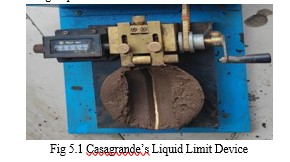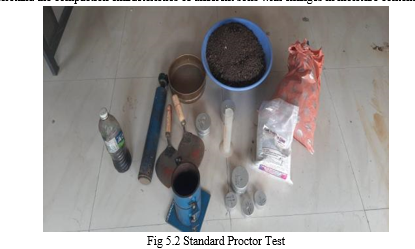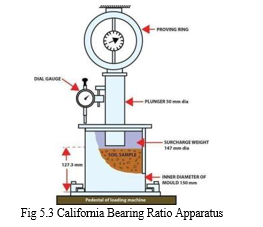Ijraset Journal For Research in Applied Science and Engineering Technology
- Home / Ijraset
- On This Page
- Abstract
- Introduction
- Conclusion
- References
- Copyright
Soil Stabilization by Using Lime and Fly Ash at Ahirwadi
Authors: Harshad Bhosale, Amrut Patil, Chaitresh Umrani
DOI Link: https://doi.org/10.22214/ijraset.2023.54093
Certificate: View Certificate
Abstract
Soil stabilization is a crucial aspect of civil engineering, particularly in the construction of infrastructure projects. This study investigates the effectiveness of lime and fly ash as soil stabilizers and their combined application for enhancing soil properties. The objective of this research is to evaluate the changes in the geotechnical properties of soil treated with lime and fly ash, including compressive strength, shear strength, and durability. In this experimental study, different proportions of lime and fly ash were mixed with the soil samples to determine the optimal combination that yields the highest improvement in soil characteristics. The laboratory tests conducted on the stabilized soil samples included compaction tests and unconfined compressive strength tests. The samples were cured for different periods to assess the long-term performance and durability of the stabilization technique. The results indicate that the addition of lime and fly ash significantly improves the soil\'s engineering properties. The lime effectively increases the soil\'s pH, reducing plasticity and improving workability. The fly ash, on the other hand, enhances the pozzolanic reactivity and improves the soil\'s strength and durability. The combination of lime and fly ash demonstrates synergistic effects, leading to further improvements in the stabilized soil\'s properties.
Introduction
I. INTRODUCTION
A. General
We should take into account a significant aspect, for example, the soil properties, before we begin construction work. The stability of the planned project is determined by factors such as loading capacity, moisture content, texture, and type of soil. In general, the BSCs have low-strength engineering properties and may require stabilization to improve their performance. Stabilization of soils is a process that can enhance soil characteristics and the profitability of construction.
The selection of material is mainly based on its difficulty in recycling and disposal, which also poses a major problem to the world community as well as making it readily available and affordable from all materials. With improved research, this method of soil improvement can thus be seen as both a reliable and efficient way to improve soils. The effect of crushed glass on the properties of engineering or soils made from black cotton is shown in this paper. Underground building materials are mainly black cotton soil, which poses a major problem for foundation work and road surfaces.
B. Need for Study
Soil properties vary greatly, and the construction of structures is highly dependent on the bearing capacity of the soil. Therefore, there is a need to stabilize bearing soils, more easily predict bearing capacity, and even improve bearing capacity. Floor grading is also a very important characteristic to consider when working with floors. Soils can be well-graded, which is desirable because they are low porosity, or they can appear to be firm but have a lot of porosity. Therefore, different soil types work together to improve soil strength properties. Complete replacement of substandard soil is very expensive, so soil stabilization is necessary in such cases.
Underground materials mainly black cotton soil, poses a major problem for foundation work and road surface at Ahirwadi which is situated in Tal. - Walwa, Dist.- Sangli.
II. LITERATURE SURVEY
- Oza et al., 2013, “Study of black cotton soil characteristics with cement waste dust and lime”
A study of the compaction properties of dark cotton soils showed that dark cotton soils mixed with a mixture of 6% SDA and 4% lime by weight can achieve ideal performance during service life. The results of this study were consistent with the adoption of dark cotton for use as the base material. Further testing included an improvement in specific gravity from 2.34 to 2.37, a decrease in liquid cutoff from 84.2 to 40.6%, and an increase in plastic breakpoint from 28.0 to 33.3%. Thus, the overall flexibility list dropped from 56.2% to 7.3%. Swelling without difference was also improved, decreasing from 79% to 25.2%.
2. Tharani et al., 2021, “An experimental investigation of soil stabilization using hybrid fiber and lime”
A blend of FA+GP admixtures currently being tested has been shown to be an effective stabilizer to improve the properties of BC soils. This is evident from the results of various tests in our test report. Estimates of unconfined compressive strength were extended significantly, with 4% of the FA+GP blend considered more convincing for developing soils in British Columbia. The 4% FA+GP blend increased compressive strength by 69% over normal strength. The soil-liquid breakpoint value of BC decreased significantly with the expansion of the FA+GP mixture at different rates. This is important to reduce soil volume changes.
3. Harika et al., 2020, “Stabilization of expansive subgrade soil by using fly ash”
In this review, the impact of restoring time on the strength properties of dark cotton soil balanced out with joined quarry residue and CKD admixture estimated in an unconfined pressure test was assessed. Soil blends ready at ideal com-agreement particle boundaries and compacted with British standard light (BSL) compaction exertion were tried after 0, 7, 14, 21, and 28curing days. Fundamental tests completed on the dirt combinations showed that there was a decrease in LL, PI, and dry unit weight, sporadic pattern in the variety of plastic cut off, and an expansion in OMC of soil blend.
III. OBJECTIVE
The objectives of the present study are to,
- To determine the optimum content of fly ash and lime by conducting the liquid limit test, plastic limit, and plasticity index.
- To determine the optimum moisture content and maximum dry density by conducting the proctor compaction test.
- To determine the CBR value of black cotton soil mixed with different percentages of lime and fly ash
- To compare the different parameters (liquid limit, plastic limit, standard proctor test) of black cotton soil for stability improvement.
IV. DATA COLLECTION
A. Data Collection
Soil samples were taken from a nearby affected area at Ahirwadi. Known to have a clayey subsoil. Fly ash is a fine-gray powder consisting mostly of spherical, glassy particles that are produced as a byproduct in coal-fired power stations. Fly ash has pozzolanic properties, meaning that it reacts with lime to form cementitious compounds. It is commonly known as a supplementary cementitious material. Lime is a calcium-containing inorganic mineral composed primarily of oxides, and hydroxide, usually calcium oxide and/or calcium hydroxide. It is also the name for calcium oxide which occurs as a product of coal-seam fires and in altered limestone xenoliths in volcanic eject.

Table 4.1 Physical properties of fly ash
|
Sr. No. |
Characteristics |
Values |
|
1 |
Specific gravity |
2.07 |
|
2 |
Fineness |
290 m2/kg |
|
3 |
Bulk density |
1100-1200 kg/m3 |
|
4 |
Color |
Light grey |
V. EXPERIMENTAL WORK
A. General
The chapter includes information on tests, procedures followed, and observation of soil samples.
The various tests were conducted on the Geotechnical Parameters, which are the following,
- Water Content [Oven Dry Method]: The knowledge of the natural moisture content is essential in all soil mechanics studies. To sight a few, natural moisture content is used in determining the bearing capacity and settlement.
- Atterberg Limit
a. Liquid Limit: If the natural moisture content of the soil is closer to the liquid limit, the soil can be considered as soft if the moisture content is lesser than the liquid limit, and the soil can be considered as soft if the moisture content is lesser than the liquid limit.
b. Plastic Limit: Soil is used for making bricks, tiles, and soil cement blocks in addition to its use as a foundation for structures.
c. Plastic Index: In general, the plasticity index depends only on the amount of clay present. It indicates the fineness of the soil and its capacity to change shape, without altering its volume.
3. Compaction Test (Standard Proctor Test): It is used to determine the compaction of different types of soil and the properties of soil with a change in moisture content.
4. California Bearing Ratio Test: The California bearing ratio test is a penetration test meant for the evaluation of the subgrade strength of roads and pavements. This is the most widely used method for the design of flexible pavement.
B. Observation
- Water Content [Oven Dry Method]
The soil sample passed through 4.75 mm and the oven maintained at a temperature of 110 ±5oC
W = [W2 –W3] / [W3 –W1] * 100%
An average of three determinations should be taken. A sample calculation is shown below.
Following table 4.1 shows the water content of the given samples.
Table 5.1 Determination of Water Content
|
S. No. |
Sample No. |
1 |
2 |
3 |
4 |
|
1 |
Weight of container with lid (W_{1} gm.) |
29 |
29 |
29 |
29 |
|
2 |
Weight of container with lid +wet soil |
49 |
79 |
63 |
61 |
|
3 |
Weight of container with lid +dry soil |
47.5 |
74.5 |
59.5 |
56.5 |
|
4 |
W = [(W_{2} -W_{3} )/(W_{3} -W_{1} )]*100 |
0.081 |
0.0989 |
0.1147 |
0.1636 |
From the above table, the average water content of the given soil sample is 11.45%.
2. Liquid Limit
The liquid limit is the water content where the soil starts to behave as a liquid. Liquid limit is measured by placing a clay sample in a standard cup and making a separation using a spatula.

Following table 4.3 shows the calculation of the liquid limit test of Black cotton soil. This method is used to find the water content of the Soil sample.
Table 5.2 Determine Liquid Limit of Only Soil Sample
|
Determination No. |
1 |
2 |
3 |
|
|
Number of blows |
40 |
30 |
20 |
|
|
Container No. |
1 |
2 |
3 |
|
|
Mass of the (container + |
gm |
54 |
56.5 |
51.5 |
|
Mass of the (container + |
gm |
46 |
50 |
43.5 |
|
Mass of water |
gm |
8 |
6.5 |
8 |
|
Mass of container (W_{0} ) |
gm |
28.5 |
29 |
28.5 |
|
Mass to dry soil |
gm |
17.5 |
21 |
15 |
|
Moisture content (w) % |
45.33 |
30.95 |
53.33 |
From the above table, the average value of the liquid limit of the given soil sample is 43.33%.
Table 5.3 Determine Liquid Limit of with 5%lime and10%fly ash
|
Determination No. |
1 |
2 |
3 |
|
|
Number of blows |
40 |
25 |
20 |
|
|
Container No. |
1 |
2 |
3 |
|
|
Mass of the (container + |
gm |
25 |
31.5 |
29.5 |
|
Mass of the (container + |
gm |
22.5 |
28 |
26.5 |
|
Mass of water |
gm |
2.5 |
3.5 |
3 |
|
Mass of container (W_{0} ) |
gm |
14 |
14 |
14 |
|
Mass to dry soil |
gm |
8.5 |
14 |
12.5 |
|
Moisture content (w) % |
29.41 |
25 |
24 |
From the above table, the average value of liquid limit soil with 5% lime and 10% fly ash is 26.13%.
Table 5.4 Determine the liquid limit of soil with 10% lime and 20% fly ash
|
Determination No. |
|
1 |
2 |
3 |
|
Number of blows |
|
45 |
25 |
14 |
|
Container No. |
|
1 |
2 |
3 |
|
Mass of the (container + |
gm |
25 |
35.5 |
37 |
|
Mass of the (container + |
gm |
24.5 |
31 |
34 |
|
Mass of water |
gm |
3.5 |
4.5 |
3 |
|
Mass of container (W_{2} ) |
gm |
12 |
13.5 |
13.5 |
|
Mass to dry soil |
gm |
12.5 |
17.5 |
20.5 |
|
Moisture content (w) % |
|
28 |
25 |
14.63 |
From the above table, the average liquid limit of soil with 10% lime and 20% fly ash sample is 22.78%.
Table 5.5 Determine the liquid limit of soil with 15% lime and 30% fly ash
|
Determination No. |
|
1 |
2 |
3 |
|
Number of blows |
|
32 |
20 |
14 |
|
Container No. |
|
1 |
2 |
3 |
|
Mass of the (container + |
gm |
58 |
61 |
66 |
|
Mass of the (container + |
gm |
52 |
54 |
57.5 |
|
Mass of water |
gm |
6 |
7 |
8.5 |
|
Mass of container (W_{0} ) |
gm |
28 |
27.5 |
29.5 |
|
Mass to dry soil |
gm |
24 |
26.5 |
28 |
|
Moisture content (w) % |
|
20 |
21.41 |
22.35 |
From the above table, the average liquid limit of soil with 15% lime and 30% fly ash sample is 21.25%.
3. Plastic Limit
The plastic limit is defined as the water moisture content at which a thread of soil with a 3.2mm diameter begins to crumble.
Table 5.6 Determine Plastics Limit of only soil sample
|
Determination No. |
1 |
2 |
3 |
|
|
Mass of (container + wet soil) W_{1} |
1 |
2 |
3 |
|
|
Mass of (container + dry |
gm |
30 |
30.5 |
31 |
|
|
gm |
29.5 |
30 |
30.5 |
|
Mass of water |
gm |
0.5 |
0.5 |
0.5 |
|
Mass of container (W_{0} ) |
gm |
28 |
29 |
28.5 |
|
Mass of dry soil |
gm |
0.15 |
0.5 |
0.2 |
|
Water content (w) % |
|
33.33 |
100 |
25 |
|
Plastic limit (PL) |
|
52.77 |
||
From the above table, the average plastics limit value of the given soil sample is 52.77%.
Determine Plastics Index of Only Soil:
Plastics Index = Liquid Limit - Plastics Limit
Ip = WL - WP
= 52.77 - 43.33
= 9.44%
Table 5.7 Determine Plastics Limit of soil with 5% lime and 10% fly ash
|
Determination No. |
|
1 |
2 |
3 |
|
Container No. |
|
1 |
2 |
3 |
|
Mass of (container + wet |
gm |
16.5 |
15.5 |
16 |
|
Mass of (container + dry |
gm |
16 |
15 |
15 |
|
Mass of water |
gm |
0.5 |
0.5 |
1 |
|
Mass of container (W_{0} ) |
gm |
16 |
15 |
15 |
|
Mass of dry soil |
gm |
0.15 |
0.5 |
0.2 |
|
Water content (w) % |
|
25 |
50 |
66.66 |
|
Plastic limit (PL) |
|
47.22 |
||
From the above table, the average plastics limit value of soil with 5% lime and 10% fly ash sample is 47.22%.
Determine Plastics Index of Soil 5% Lime 10% Fly Ash:
Plastics Index = Liquid Limit - Plastics Limit
Ip = WL - WP
= 42.22 - 26.13
= 21.09%
Plastic limits can be used to determine the optimal water content for tillage without adversely affecting the soil structure 13 and are also useful in assessing the impact of long-term land use and tillage on the mechanical and rheological behavior of soil.
4. Standard Proctor Test
The Proctor compaction test is a laboratory method of experimentally determining the optimum moisture content at which a given soil type will become densest and achieve its maximum dry density. The test is named in honor of Ralph R. Proctor. Compaction can be generally defined as the densification of soil by the removal of air and rearrangement of soil particles through the addition of mechanical energy. The energy exerted by compaction forces the soil to fill available voids, and the additional frictional forces between the soil particles improve the mechanical properties of the soil. Because a wide range of particles is needed in order to fill all available voids, well-graded soils tend to compact better than poorly-graded soils. A compaction test of soil is carried out using Proctor’s test to understand the compaction characteristics of different soils with changes in moisture content.

a. Determine Optimum Moisture Content of Standard Proctor Test
The optimum moisture content provides the maximum dry unit weight that can be obtained. The increase in dry unit weight means improving the soil properties strength, and decreasing permeability and compressibility so it is better to use the optimum moisture content.
Table 5.8 Optimum moisture content
|
Optimum |
Only soil |
5%Lime |
10%Lime |
15%Lime |
|
Water |
0.0939 |
0.1099 |
0.1421 |
0.1381 |
b. Determine Maximum Dry Density of Standard Proctor Test
The maximum peak point of the soil compaction curve obtained is called the maximum dry density value. The water content that corresponds to this point is called optimum water content. Bulk density or dry density is defined as the ratio of the mass of a solid to the total volume of soil.
Table 5.9 Maximum dry density
|
Maximum dry |
Only soil |
5%Lime |
10%Lime |
15%Lime |
|
Water |
0.0068 |
0.0069 |
0.0057 |
0.0045 |
5. California Bering Ratio Test [CBR]
This test is commonly termed as CBR test. California bearing ratio value is defined as the ratio of load per unit area required. To penetrate a soil mass by a standard plunger at a specified rate to that corresponding required for penetration of a standard material. This standard material is the one defined.
CBR is the ratio expressed in the percentage of force per unit area required to penetrate a soil mass with a standard circular plunger of 50 mm diameter at the rate of 1.25 mm/min to that required for corresponding penetration in a standard material. The ratio is usually determined for penetration of 2.5 and 5 mm. When the ratio at 5 mm is consistently higher than that at 2.5 mm, the ratio at 5 mm is used.

According to results obtained from laboratory tests, it is concluded that stabilization of black cotton soil by using Lime and Fly Ash. From the results, it is observed that due to the increase in lime and fly ash percentage in black cotton soil, there is a significant change in CBR value as compared to untreated black cotton soil.
C.B.R. = Test load/Standard load * 100
Without lime and fly ash:
1. C.B.R. of specimen at 2.5 mm penetration: 189/1370*100=13.79%
2. C.B.R. of specimen at 5 mm penetration: 235/2055*100=11.43%
With lime 5% and fly ash 10%:
1. C.B.R. of specimen at 2.5 mm penetration: 202/1370*100=14.74%
2. C.B.R. of specimen at 5 mm penetration: 248/2055*100=12.06%
With lime 10% and fly ash 20%:
1. C.B.R. of specimen at 2.5 mm penetration: 211/1370*100=15.40%
2. C.B.R. of specimen at 5 mm penetration: 258/2055*100=12.55%
With lime 15% and fly ash 30%:
1. C.B.R. of specimen at 2.5 mm penetration: 216/1370*100=15.76%
2. C.B.R. of specimen at 5 mm penetration: 266/2055*100=12.94%
VI. FUTURE SCOPE
- Instead of the addition of the above stabilizing material, the Stabilization of black cotton soil can be done by using materials like lime, fly ash wastes, and cement, or a combination of all.
- Geogrids can be used as reinforcing material to increase the strength of black cotton soil.
- Stabilization of black cotton soil was also studied by using the addition of scrap & low-cost materials which are highly intense to the environment.Top of Form
Conclusion
According to results obtained from laboratory tests, we have concluded that, 1) The liquid limit and plastic limit of Black cotton soil decrease with an increasing percentage of lime and fly ash. 2) Maximum dry density, and California bearing ratio of black cotton soil increase with an increase in the percentage of stabilizing materials. 3) With the increase in the percentage of lime and fly ash maximum dry density starts increasing and optimum moisture content increases up to 5%lime and 10%fly ash and after starts decreasing 4) In addition 5%lime and 10%fly ash gives the maximum value of optimum moisture content and standard proctor test. 5) With the increase in the percentage of lime and fly ash resulting from (5%, 10%, 15% and 10%, 20%, 30%) optimum moisture content and California bearing ratio of black cotton soil increases. 6) With the increase in the percentage of lime and fly ash, maximum dry density starts increasing & optimum moisture content starts decreasing.
References
[1] J. B. Oza and P. J. Gundaliya, “Study of black cotton soil characteristics with cement waste dust and lime,” in Procedia Engineering, 2013, vol. 51, pp. 110–118. doi: 10.1016/j.proeng.2013.01.017. [2] K. Tharani, G. Palani Selvan, T. Senbagam, and G. Karunakaran, “An experimental investigation of soil stabilization using hybrid fibre and lime,” Materials Today: Proceedings, Apr. 2021, doi: 10.1016/j.matpr.2021.03.380. [3] P. G. Kumar and S. Harika, “Stabilization of expansive subgrade soil by using fly ash,” in Materials Today: Proceedings, 2020, vol. 45, pp. 6558–6562. doi: 10.1016/j.matpr.2020.11.469. [4] V Amadi, “Enhancing durability of quarry fines modified black cotton soil subgrade with cement kiln dust stabilization,” Transportation Geotechnics, vol. 1, no. 1, pp. 55–61, 2014, doi: 10.1016/j.trgeo.2014.02.002. [5] S. Osu, “Effect of curing time on strength development in black cotton soil – Quarry fines composite stabilized with cement kiln dust (CKD),” Journal of King Saud University - Engineering Sciences, vol. 30, no. 4, pp. 305–312, Oct. 2018, doi: 10.1016/j.jksues.2016.04.001. [6] M. Lekha, G. Sarang, and A. U. R. Shankar, “Effect of Electrolyte Lignin and Fly Ash in Stabilizing Black Cotton Soil,” Transportation Infrastructure Geotechnology, vol. 2, no. 2, pp. 87–101, Jun. 2015, doi: 10.1007/s40515-015-0020-0.
Copyright
Copyright © 2023 Harshad Bhosale, Amrut Patil, Chaitresh Umrani. This is an open access article distributed under the Creative Commons Attribution License, which permits unrestricted use, distribution, and reproduction in any medium, provided the original work is properly cited.

Download Paper
Paper Id : IJRASET54093
Publish Date : 2023-06-15
ISSN : 2321-9653
Publisher Name : IJRASET
DOI Link : Click Here
 Submit Paper Online
Submit Paper Online

